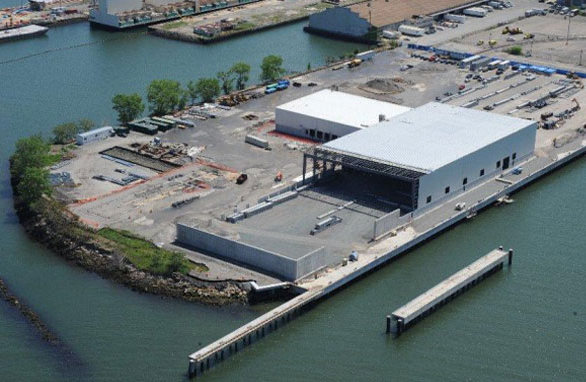Building Elevation and Floating
Elevate the Building on Fill
What Is It?

Sims Municipal Recycling
Elevating a building above base flood elevation (BFE) is an effective way to provide protection from storm-related flooding, as well as flooding from high tide due to sea level rise. A building can be raised above base flood elevation by usingfill to elevate the building or to reshape the entire building site’s topography. Due to the significant modifications needed to bring the building site above BFE, elevating a building on fill is much more difficult for retrofits. Proper elevation of a site may provide reductions in flood insurance premiums—or even entirely remove the site from the flood zone by obtaining a letter of map revision.
While elevating a building site above BFE will provide protection from some flooding, it will not protect the site from wave action, which may scour the fill. As a result, FEMA does not permit the use of structural fill in V zones. Elevation of sites over three feet is not recommended, as channelization can occur and flooding of adjacent, lower areas could be exacerbated. Proper assessment and mitigation of potential negative effects on the surrounding area as a result of site elevation should be considered. If the building site is not completely elevated over BFE, additional floodproofing measures can be utilized to maximize flood protection. A significant portion of the additional cost of elevating a building on fill stems from the fill itself. Use of recycled materials in the fill can help to reduce costs.
Benefits
- Protects a building from flooding by raising it above base flood elevation.
- Site elevation may reduce flood insurance premiums. Site may even potentially be removed from flood zone. Elevation of large residential/non-residential with basement/enclosure/crawlspace from base flood elevation to 3 feet above base flood elevation may reduce annual insurance rates by over 70%.
- If entire building is raised above flood elevation, building area can be preserved.
Drawbacks
- Drainage and implications of site elevation on adjacent sites may prevent elevation of the site on fill. Additional costs related to assessing drainage and impacts on adjacent sites will be necessary.
- Elevation of the building site in urban areas can create accessibility issues and have negative impacts on the streetscape and adjacent sidewalks.
- The use of a fill and potential need for retaining wall will add significant costs to a new construction project.
Regulatory Impacts and Requirements
Potential regulatory touchpoints in Boston and Massachusetts include:
- Fire Department
- Building Code/Permit
Note: the Federal Emergency Management Agency (FEMA) does not permit elevation of building sites on fills in V zones.
Financing Options, Incentives, and Rebates
- FEMA Hazard Mitigation Assistance – FEMA provides funding for flood and disaster mitigation through three grant programs: Hazard Mitigation Grant Program, Pre-Disaster Mitigation, and Flood Mitigation Assistance. Additional information and application instructions are available here through the Massachusetts Emergency Management Agency. Only non-residential dry floodproofing projects are eligible.
- Hazard Mitigation Funding Under Section 406 of the Stafford Act – Local, state, tribal, and some non-profit facilities damaged by disasters may use Section 406 funding to restore damaged facilities, as well as undertake preventative measures for future flood mitigation.
NEWS
- "To Combat Higher Seas, Why Not Raise Up the Town?" NPR, May 2013
- "Lifting a Town to Escape the Next Storm," New York Times, February 2013
RESOURCES
- NYC Dept. of City Planning: Urban Waterfront Adaptive Strategies
PROJECT EXAMPLES
- Sunset Park Material Recovery Facility, NY (pg. 42)


